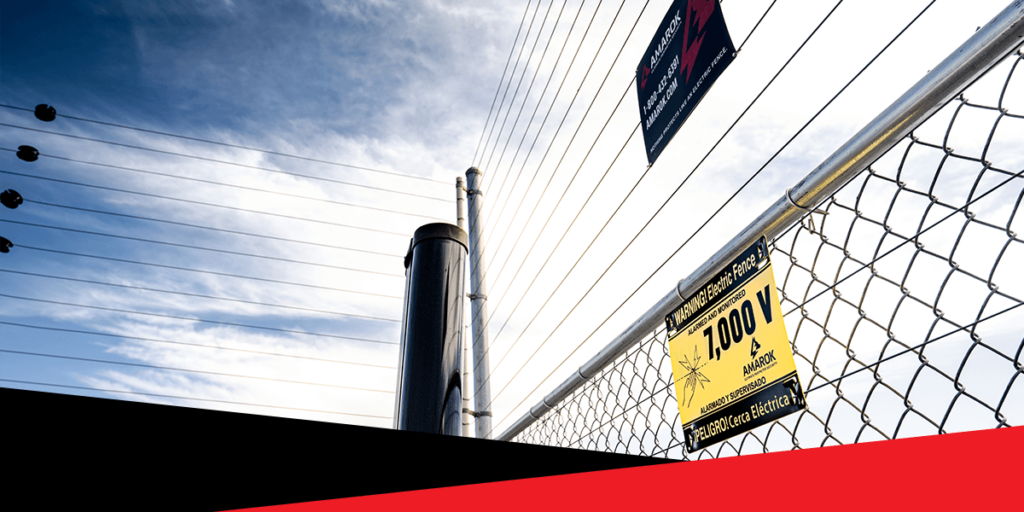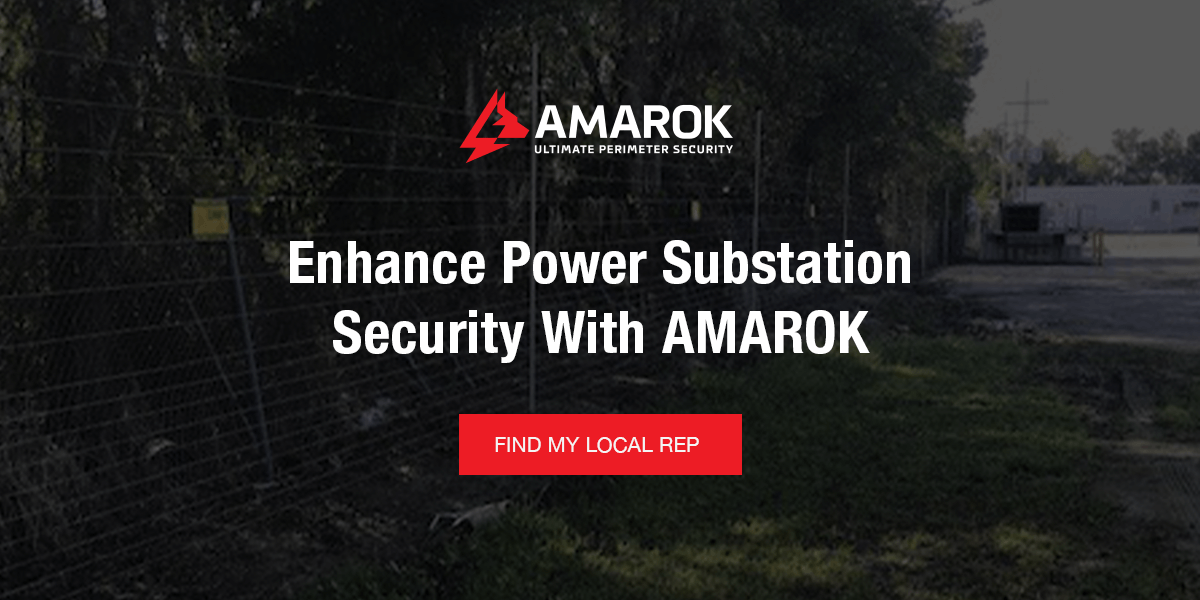Protecting power substations is essential for maintaining the electric grid’s stability and safeguarding critical infrastructure. These facilities are crucial to the national power grid and are often vulnerable to a range of physical threats. Securing them helps protect the transformers, control systems, and switchgear that support their function, which in turn prevents widespread outages, economic disruptions, and national security threats.
Mitigating these risks demands a capable physical security system, which can include barriers, surveillance, and immediate-response protocols. Utilities can ensure that substations remain resilient against a wide range of potential threats by implementing these practices.
Understanding the Risks
Power substations without robust physical security are a critical vulnerability. These substations are essential for distributing electricity and ensuring that power reaches homes, businesses, and vital infrastructure. When left unprotected, they expose the substation to several significant risks:
- Theft and vandalism: Substations are frequently targeted for theft because they contain copper and other valuable materials. Stolen components and damage to critical equipment can cause prolonged outages and costly repairs.
- Physical attacks: Substations are vulnerable to targeted attacks, which can severely damage equipment and lead to widespread power outages.
- Environmental hazards: Substations without protection are exposed to natural threats like severe weather. Without reinforced enclosures, they’re vulnerable to storms, flooding, and fire.
- Operational downtime: Physical damage to equipment like transformers can take weeks to repair. Some highly specialized equipment requires time-intensive repair or replacement, which can strain resources.
Regulatory and Compliance Considerations
To mitigate these risks, government agencies have established guidelines and regulatory standards that electric utilities must follow. Failing to secure substations can lead to regulatory penalties, legal action, and higher insurance premiums.
The North American Electric Reliability Corporation (NERC) sets Critical Infrastructure Protection (CIP) standards that include physical security measures for critical substations. Specifically, CIP-014-4 states that utilities must assess threats and vulnerabilities and implement physical security plans.
In addition to these regulations, enforced by the Federal Energy Regulatory Commission (FERC), there are sometimes state and local requirements. Local authorities may require utilities to conduct vulnerability assessments and take safety measures in areas prone to specific risks like high crime rates. These measures can include fencing, surveillance, or alarm systems.
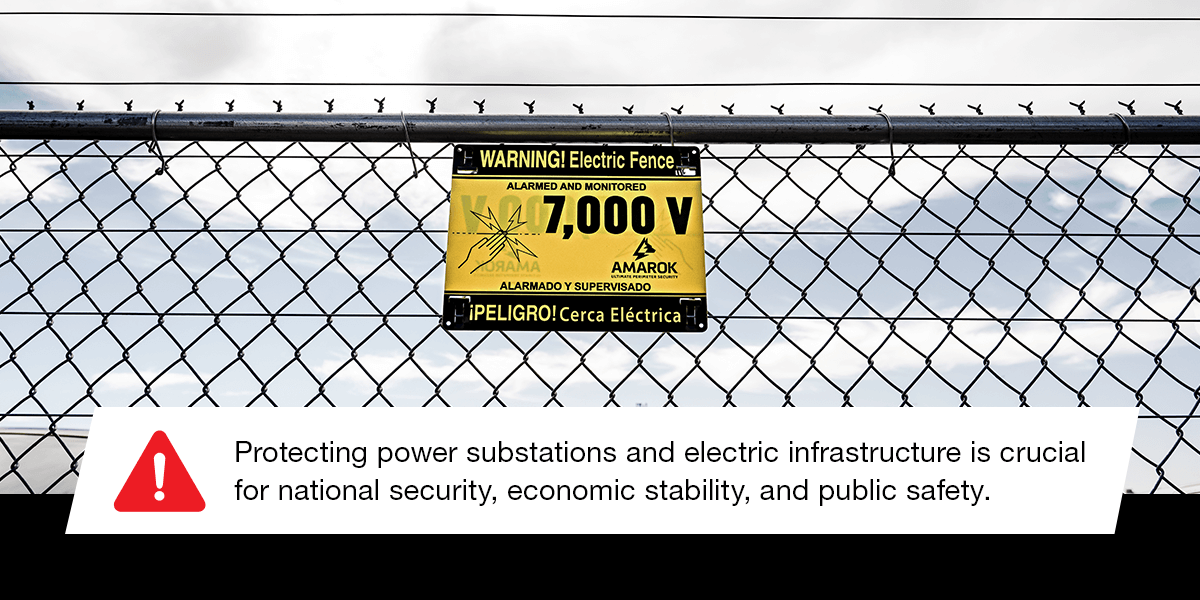
Why It’s Important to Protect Power Substations
Protecting power substations and electric infrastructure is crucial for national security, economic stability, and public safety. These facilities are the backbone of the energy grid, delivering electricity to homes, businesses, and critical services. Here’s why they must be safeguarded:
National Security
Substations are vital to national defense and emergency response. A power grid failure can disrupt emergency services, military operations, and essential government functions. A widespread or prolonged blackout can create chaos, weaken public trust, and pose further threats.
Economic Stability
Substation outages have a ripple effect that affects businesses, manufacturing, health care, and transportation, leading to economic disruptions. These power disruptions lead to productivity losses, supply chain issues, and financial instability. Even short outages can cost businesses millions in lost revenue, while prolonged blackouts can trigger economic downturns.
Public Safety
Substations power critical infrastructure such as hospitals, police stations, and water treatment facilities, which means that power outages can delay medical care and access to clean water. If power loss occurs during extreme weather conditions, entire communities may be left vulnerable and unable to access heating, cooling, or communication. These disruptions can also delay emergency response and put lives at risk.
Key Components of Physical Security
Safeguarding a power substation’s essential infrastructure from theft, sabotage, and unauthorized access is crucial. Doing so involves implementing a range of strategic measures designed to protect personnel, assets, and operations, starting with effective physical security systems.
The right security solution will greatly reduce the risk of power interruptions and enhance resilience against external threats.
Perimeter Defense
The first line of protection for any power substation is its perimeter. Establishing a perimeter involves setting up fencing and controlled access points to secure the site’s outer limits. Strong perimeter defenses deter intruders, establish clear boundaries, and help security personnel monitor and manage access effectively.
As the first line of defense, your fencing should offer excellent security. You can enhance your existing perimeter with additions like angled fencing, gate auto arming, remote arming, lay-down fencing to deter digging, vegetation control, and security bollards to add physical strength. For the best possible deterrence, consider placing an electric fence within the bounds of your current perimeter barrier.
Key components of the perimeter defense can be a combination of:
- Fencing: High-security fencing deters unauthorized entry. Many substations use chain-link fences with barbed or razor wire to increase deterrence.
- Electric fencing: An electric fence delivers a safe but memorable pulsed shock to stop would-be intruders before they access the property. Because these fences are marked with universally known warning signs, they are also an effective visual deterrent that discourages criminal activity.
- Barriers: Bollards and crash barriers provide protection against vehicle intrusion. These barriers are positioned to prevent vehicles from ramming into critical equipment.
- Buffer zones: Maintaining a clear zone around the perimeter helps prevent concealment and provides a line of sight for monitoring.
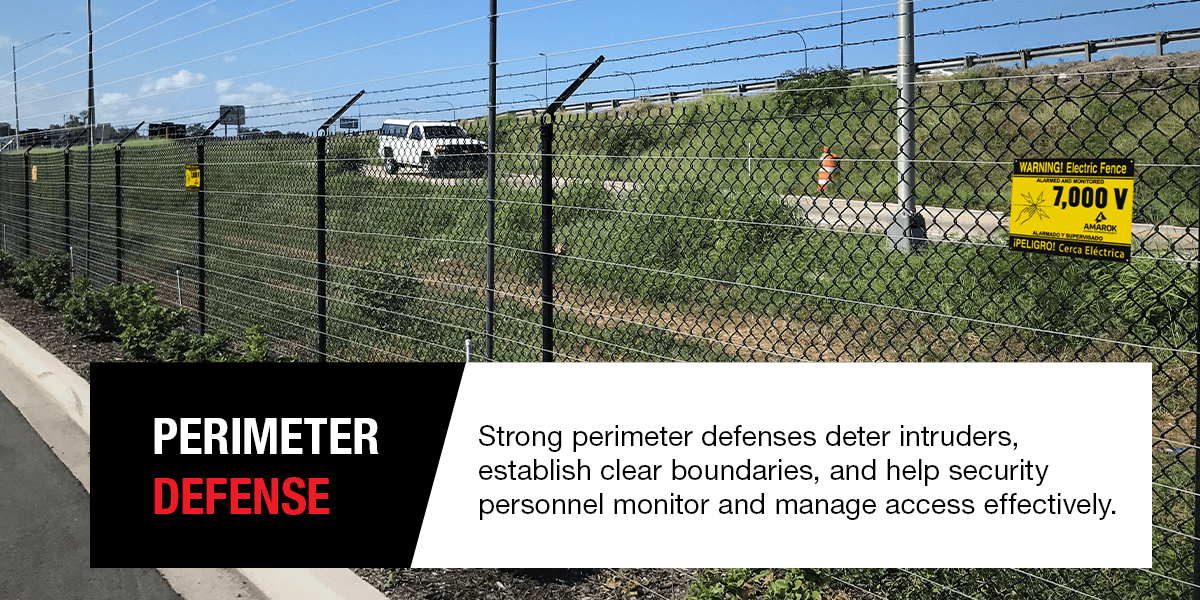
Property Surveillance
Surveillance plays a key role in monitoring and securing a substation’s facilities. With round-the-clock camera coverage, thermal imaging, and remote monitoring, surveillance systems detect and record unauthorized access, equipment tampering, and potential hazards. Effective systems act as both a deterrent and rapid alert system for suspicious activity:
- Cameras: High-definition cameras provide 24/7 monitoring. They should cover key entry points, critical assets, and blind spots.
- Thermal imaging: Thermal cameras detect intrusions in low visibility, including at night, and can be paired with analytics for real-time alerts.
- Remote monitoring: Centralized or remote monitoring allows rapid response to incidents. Substations often link their feeds to a central security center for quicker action.
Access Control
Access control manages who can enter, exit, and operate within the substation. Through tools like keycard access, this security solution minimizes the risk of power cuts due to tampering. Gate access control can include measures such as credential readers and video intercoms, mag locks, key fobs, pin codes, and on-demand activity reports. These variables can be categorized as:
- Controlled entry points: Restricted access gates and doors reduce the chances of unauthorized entry. These points should use durable, tamper-resistant locks.
- Badging systems: Employee and contractor access should be tightly controlled through identification badges, proximity cards, or biometric systems.
- Two-factor authentication: For added security, two-factor authentication is recommended at entry points to ensure that only authorized personnel can access sensitive areas.
Intrusion Detection
Actively monitoring for unauthorized access attempts can alert security personnel to potential breaches. Intrusion detection systems provide an early warning to prevent incidents before they escalate. Components of these systems can include:
- Fence alarms: Vibration sensors on fences can trigger alerts if someone attempts to cut or climb over the barrier, providing early warning of a potential intrusion.
- Sensors and alarms: Motion detectors, pressure sensors, and alarms alert security personnel to unauthorized access attempts. These systems should be placed along the perimeter, at entry points, and in sensitive areas.
- Access detection: Motion sensors and tamper alarms placed directly on equipment draw attention to sabotage or theft attempts.
Boundary Lighting
Illuminating key areas around the substation deters intruders and improves surveillance visibility. Effective lighting enhances detection and response, especially at night, by reducing potential hiding spots and making the site visible to on-site and remote monitors. Lighting systems include:
- Alarm-based lighting: Alarm-based lighting integrates with electric fencing to enhance perimeter security with immediate response capabilities.
- Floodlights: High-intensity lighting deters intruders and assists security personnel in monitoring the area. Lights should cover the perimeter, entry points, and critical infrastructure.
- Motion-activated lighting: Motion-sensor lighting serves as both a deterrent and an alert, illuminating areas where activity is detected when the sensors identify movement.
Emergency Response
Emergency response planning is critical to ensuring coordinated action during security incidents or emergencies. Detailed protocols, training, and coordination with local authorities ensure that staff can respond effectively to incidents. A sound emergency response plan covers:
- Response protocols: Detailed response plans for various threat levels ensure personnel can act quickly and effectively. Plans should be reviewed regularly and updated as needed.
- Employee training: Regular training on security protocols and emergency response is crucial. Employees need to know how to respond quickly and effectively in case of an intrusion.
- Collaborative efforts: Proactive coordination with local law enforcement and emergency services is vital for effective incident response. Training exercises can help responders prepare for substation-specific scenarios.
Tips for Protecting Power Substations
Several additional ways exist to protect power substations and electrical infrastructure. These measures deter potential threats while allowing for rapid detection and response to breaches. Implementing additional measures like the following contributes to the overall resilience of the power grid.
Deploy Advanced Surveillance Analytics
Behavioral analytics can help identify suspicious activities like loitering, unauthorized vehicle parking, and unusual movement patterns. Using license plate recognition technology to track vehicles entering and exiting the site can also help identify unauthorized vehicles while maintaining a record of all entries. Larger substations can also use drones for aerial surveillance of larger substations. These provide a bird’s-eye view, which is useful in hard-to-access areas and during incidents that might compromise on-the-ground monitoring.
Implement Redundant Communications Systems
Establish redundant communication channels for security systems, such as both cellular and hardwired connections. This practice ensures that critical alerts and data transmission continues even if one network fails. Equip personnel with audio systems independent of the primary network, allowing on-site teams to communicate even if there’s a power or network outage.
Conduct Regular Vulnerability Assessments
Schedule routine threat simulations, like emergency drills and mock intrusions, to evaluate the substation’s defense readiness. Testing real-world scenarios helps identify gaps in substation security protocols and responses. Conduct security audits of all equipment, structures, and systems to ensure no weak points have developed due to wear or environmental changes.
Follow Crime Prevention Through Environmental Design
Following the principles of Crime Prevention Through Environmental Design (CPTED) establishes a focus on creating safe physical environments through lighting, landscaping, and other environmental factors.
Arrange structures and landscaping to maximize substation visibility, eliminating any cover or hiding spots around critical areas. Position sensitive equipment deeper within the substation, away from perimeter fences, so there are more barriers to traverse before reaching critical assets.
Benefits of a Multi-Layered Security System
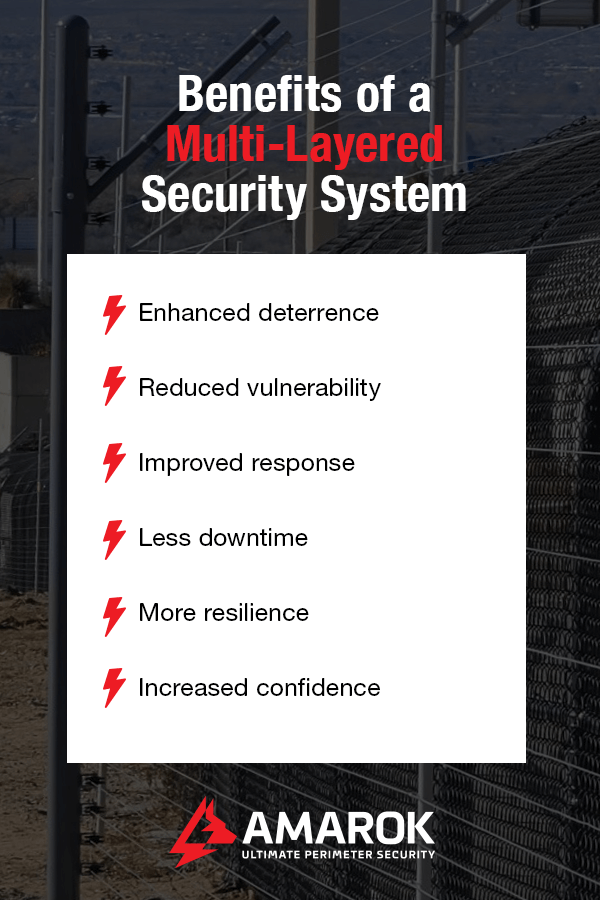
A multi-layered security system is a strategic approach that combines multiple defensive measures, creating layers of protection around power substations. Rather than relying on a single security feature, this approach integrates perimeter defenses, surveillance, access control, intrusion detection, lighting, and emergency protocols. Remote video monitoring, ground wire monitoring, motion detectors, and building intrusion detection are also options to boost these efforts.
Each layer acts as an independent barrier to delay or prevent unauthorized access, ensuring overall protection and resilience through these benefits:
- Enhanced deterrence: Multiple layers make it harder for potential intruders to approach critical infrastructure without detection. Visible barriers, surveillance, and lighting reduce the likelihood of attempted breaches.
- Reduced vulnerability: A layered approach addresses different types of threats, from sabotage to physical intrusions. Each layer covers specific vulnerabilities to eliminate potential weak points.
- Improved response: Having multiple detection points enables quick identification of security incidents. Detecting issues promptly allows security teams to respond quicker, preventing further compromise.
- Less downtime: Early detection reduces the likelihood of intrusion impacting substation operations. This factor prevents damage to critical assets, protects grid stability, and lowers potential operational downtime.
- More resilience: Infrastructure threats evolve consistently, and a multi-layered security system is more adaptable and scalable. This structure allows utilities to add or upgrade security layers, ensuring long-term protection with up-to-date defenses.
- Increased confidence: A multi-layered security system shows commitment to safety, reassuring stakeholders, regulatory bodies, and the public that substations are protected by robust, comprehensive measures.
Enhance Power Substation Security With AMAROK
Safeguarding power substations through robust physical security is essential for protecting the electric grid, ensuring reliability, and supporting communities. By implementing a multi-layered approach that combines electric fencing, perimeter defenses, surveillance, access control, intrusion detection, lighting, and coordinated emergency response plans, utilities can build resilient, adaptable protection. Each layer of security adds a barrier to prevent unauthorized access, detect attempted breaches, and allow rapid response to incidents. Prioritizing physical security at substations also reinforces public trust and confidence in the safety and stability of essential power systems.
AMAROK offers comprehensive power security solutions for various industries. We are a security-as-a-service supplier, handling all your perimeter security needs with a manageable monthly subscription fee. Each partnership starts with our perimeter security experts gaining a thorough understanding of your unique risks and compliance requirements so we can provide a turnkey solution. We then handle all the maintenance with our nationwide network of professional support technicians.
With over 50 years of industry experience, our team is ready to deliver effective electric fencing solutions and other proven security tools. Secure your substation today by finding an AMAROK representative near you.
